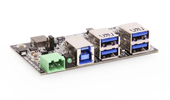
What is Extended Power Range?
Extended Power Range, or EPR, marks the new USB Type-C PD 3.1 specification boasting 240-watts top capacity, more than double the power from today’s 100-watt standard. This existing specification has now been relabeled as Standard Power Range (SPR). Those developing this technology, the USB Implementers Forum, recently revealed the power upgrade when outlining their Type-C Cable and Connector Specification version 2.1 update. EPR implementation was recently released in the fourth quarter of 2021.
What does this new standard offer?
First and foremost this 240-watt PD 3.1 power upgrade lends itself well to gaming laptops, docking stations, 4K monitors, and more. Dell, LG, and Alienware’s 4K Ultrawide monitors often see a peak power usage of over 200-watts alone.
Our focus at Coolgear however, shifts to integration with high power sensors, drawers, solenoids, kiosks, workstation clusters, robotics, automation equipment, electrical motors, and so much more.
What is Coolgear working on?
Coolgear Labs is constantly researching and always innovating. We are currently testing new products within the realm of EPR, implementing CYPM1311 & PMG1-S3 Cypress / Infineon chipsets along with buck ICs from Texas Instruments, MPS, and Injoinic (IP6550 & IP2736). We plan to sample these devices in the latter half of 2022.
Currently our labs are working on new USB PD adapters, including:
- 140-Watt USB PD Adapter for DC input applications ranging from 12- 30 Volt input. Buck or boost capable allowing output voltages lower or higher in magnitude than the input voltage. This assists the adapter in delivering the new 28V 140-watt profile even within standard automotive electrical systems that typically run 12-24V.
- 240-Watt USB PD Adapter for DC input applications ranging from 12-60 Volt input. Buck or boost capable allowing output voltages lower or higher in magnitude than the input voltage. This assists the adapter in delivering the new 28V 140-watt profile as well as the new 36 Volt and 48 Volt profiles allowing for a maximum output without cooling in a small metal chassis.
Coolgear aims to keep innovating as this emerging technology becomes the new standard. Subscribe to our newsletter for EPR updates as well as the latest news, product launches, projects, and more.
EPR Technical Specifications
Extended Power Range:
- 240W of power at 28V, 36V, and 48V at 5A.
- 48V limit for EPR to stay within safety margins.
- EPR power negotiation mirrors the current USB Power Delivery (PD) standard:
- Same sequence flow of offer, Request and Accept/Reject.
- Same requirement for connected devices, or sinks, to evaluate and respond to new power source capabilities messages.
Adjustable Voltage Supply:
- AVS enables connected devices to change the optimum voltage between 15V and 48V in steps of 100mV for improved performance and thermal efficiency.
- AVS is required in EPR in contrast to Standard Power Range (SPR) not requiring Programmable Power Supply (PPS).
Protection within EPR:
- An initial SPR explicit power contract is required before EPR can be considered.
- Sinks, connected devices, must lead the EPR entry process.
- Sources, also known as hosts, must verify that the sink and cable are EPR compatible.
- Sinks are required to supply a copy of Power Data Object (PDO) for verification within EPR Request Messages.
- Sinks must also supply messages to their respective source confirming that both ends are open and active. Within a second, sources will initiate hard resets if this “keep alive” message is not supplied. Sources will then scale back to 5V.
EPR Cable Compatibility:
- 5A Standard Power Range (SPR) cables are being deprecated entirely.
- For proper certification EPR cables are required to be visibly marked for easy identification.
- Bypass capacitors in USB cables now have a new minimum voltage rating of 63V, possibly affecting its size. Cable insulation could change due to the higher voltage.




















